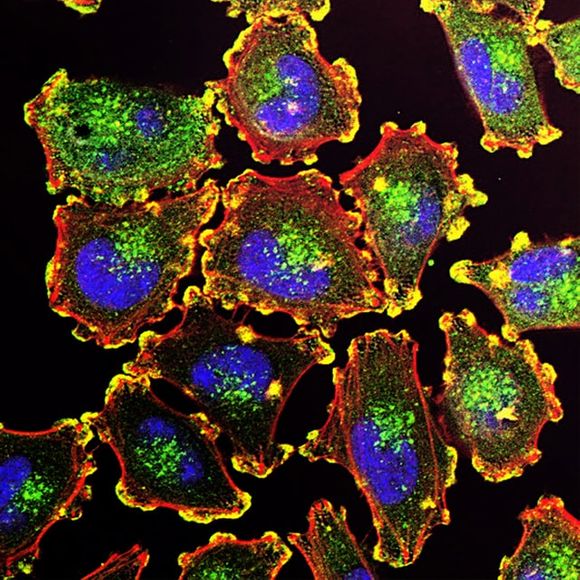Author: Sylvia Marinova, PhD student in the Genomic Stability Laboratory at BAS
Autoimmune encephalitis belongs to a group of rare diseases of the central nervous system (CNS). It occurs when our immune system mistakenly attacks healthy brain cells, leading to serious symptoms that often develop very quickly - in the order of days to weeks. The good news is that the disease is treatable and in most cases the prognosis is very good.
Causes for autoimmune encephalitis
In the case of autoimmune encephalitis, it produces antibodies whose normal function is to recognize elements that would be potentially pathogenic to the body and to defuse them.
The antibodies that the immune system produces can be directed to different proteins of nerve cells. According to their location, autoimmune encephalitis is divided into two groups.
Paraneoplastic syndrome
In the classic "well-defined" autoimmune encephalitis, the antibodies of our immune system attack proteins inside nerve cells. By blood test, serum antibodies such as anti-Hu, anti-Yo, anti-Ri [ref. 1]can be detected by a blood test .In this case, antibodies are associated with another severe disease - cancer , and the reason lies in the immune system'sresponse to an available tumorformation . paraneoplastic syndrome. The prognosis is not good [ref. 2] due to irreversible neural destruction and the severity of associated cancer.

Other types of autoimmune encephalitis
Another group of antibodies - inducing autoimmune encephalitis- targets proteins located on the surface of nerve cells. They are directly pathogenic and damage neurons, disrupting their function. The causes of the appearance of these antibodies are more unclear and are the subject of extensive scientific research. Among the proposed triggers for autoantibodies to superficial proteins of brain cells are:
- Bacterial infection - untreated infections with the bacteria Streptococus pyogenes and Campylobacter jejuni are associated with the development of autoimmune encephalitis. It is believed that the root cause lies in a molecular similarity between certain proteins of the pathogen that activate the immune system, and proteins of nerve cells.
- Viral infection - a link has been found between viruses such as Epstein-Barr (EBV, Epstein-Barr), Influenza (Influenza) and Herpes simplex and some autoimmune encephalitis.
- Some tumors - it is known that tumors have proteins on their surfacethat are not specific to the respective tissue . This may include neural proteins characteristic of the central nervous system. In thiscase, the immune system recognizes them on the tumor and produces antibodies againstthem that will be active against the natural proteins in the brain. This leads to an autoimmune reaction.
We will only mention that the above hypotheses for the occurrence of an autoimmune reaction do not in themselves fully explain it due to the fact that the brain is protected from the so-called " blood-brain barrier and in general, regardless of the cause of the production of these autoantibodies, they should not be able to reach the brain. This is possible only if the permeability of the blood-brain barrier is disturbed.
Who is at risk of autoimmune encephalitis
It is known that this disease develops more often sporadically, without family burden . It affects people ofany age and gender, but statistically a higher percentage of those who fall ill are young women [ref. 3] around the age of 20.

What are the symptoms and how to diagnose it
There are various subtypes of autoimmune encephalitis, which is due to the fact that antibodies can be against various proteins on the surface of nerve cells.
Most often, such a protein is NMDA-R, and antibodiesagainst: LGI-1, CASPR2, AMPA, GABAb, GABAa, DPPX, mGluR5, MOG, Dopamine-2R and several others can also be detected.
Generally speaking, a variety of functions of the central nervous system may be affected. Some of the symptoms may include:
- Psychosis
- Flu-like symptoms such as fever and general fatigue
- Ataxia (impaired coordination of movements)
- Muscle spasms
- Seizures
- Impaired vision and speech
- Impaired concentration, memory, difficulty holding attention
- Sleep problems
- Loss of consciousness, even coma in more severe cases
- Weakness and numbness of the limbs, etc.
It is important to note that the clinical picture sometimes develops very quickly and a timely reaction is needed. The faster the cause is established, the more likely the prognosis is to be good.
An interesting fact is that patients can not cope with the so-called " In her autobiographical book "Brain on Fire: My Month of Madness" (there is also a book film), Susana Kajalan tells of her disease from autoimmune encephalitis and how it is this test that helps diagnose it and the subsequent cure.
To make a correct diagnosis, it is necessary to exclude other diseases that may have overlapping symptoms . For this purpose, a comprehensive examination and additional tests are required. The following 3 criteria [ref. 4] must be met in order to diagnose a patient with autoimmune encephalitis:
- Rapid development of the disease in less than three months - problems with short-term memory or psychiatric symptoms;
- Justified exclusion of other possible causes;
- At least one of the following:
- Convulsions unexplained by another previous disease,
- Magnetic resonance tomography of the brain showing encephalitis,
- Pleiocytosis (increase in lymphocytes in the liquid),
- Focal findings in the central nervous system (established by electroencephalography, EEG).
It is also important to do an immunological examination of the liquid, which will indicate the presence of specific antibodies.

Treatment of autoimmune encephalitis
Usually, the treatment aims to suppress the immune system and therapy with corticosteroids and plasmapheresis is applied to eliminate autoantibodies. If this primary immunotherapy is not sufficient, sometimes treatment with the preparations rituximab and cyclophosphamide is sometimes given.
It is also important to do screening for a cancer formation.
If the cause of encephalitis is infection, then antibiotic treatment is required in bacteria orantiviral drugs, if the causative agent is a virus.
The outcome of the disease is usually good in children and adolescents. In adults, recoveryproceeds more slowly, but again the prognosis is often positive . In some cases, there may be a recurrence of symptoms, but the good news is that this happens relatively rarely.
Read more:
New approaches to the treatment of multiple sclerosis in Europe
17 affordable herbs to help multiple sclerosis sufferers
Capgra syndrome: when we think someone else is pretending to be our loved one








